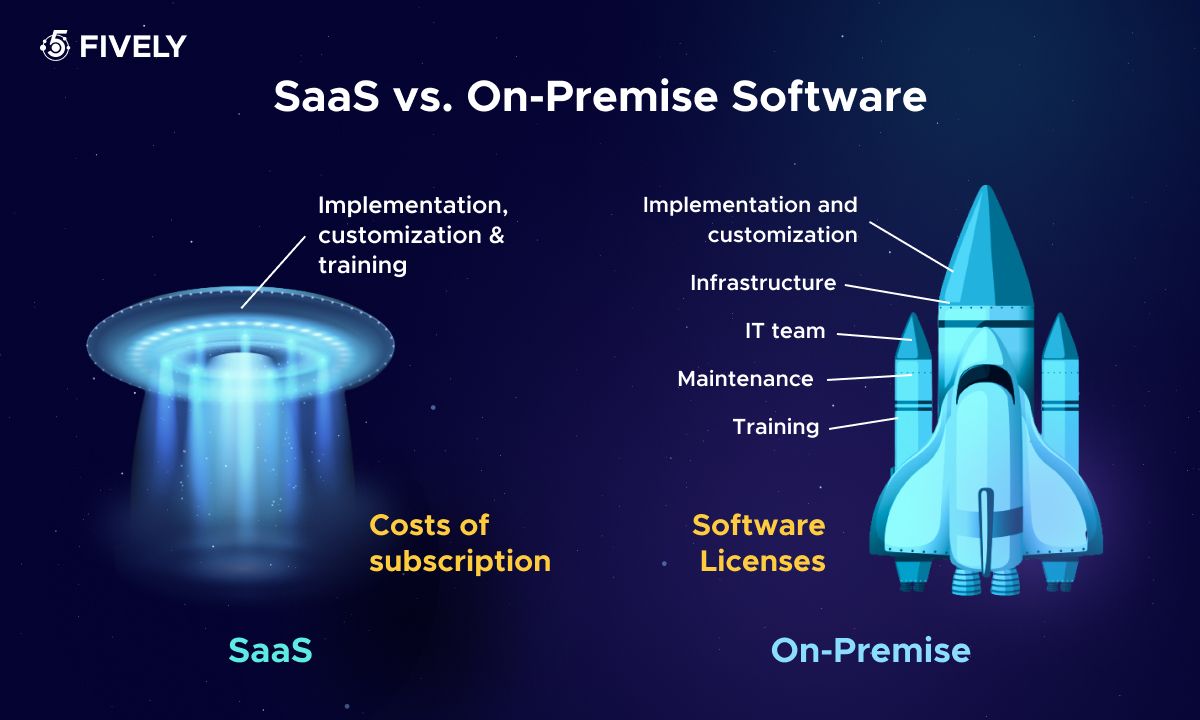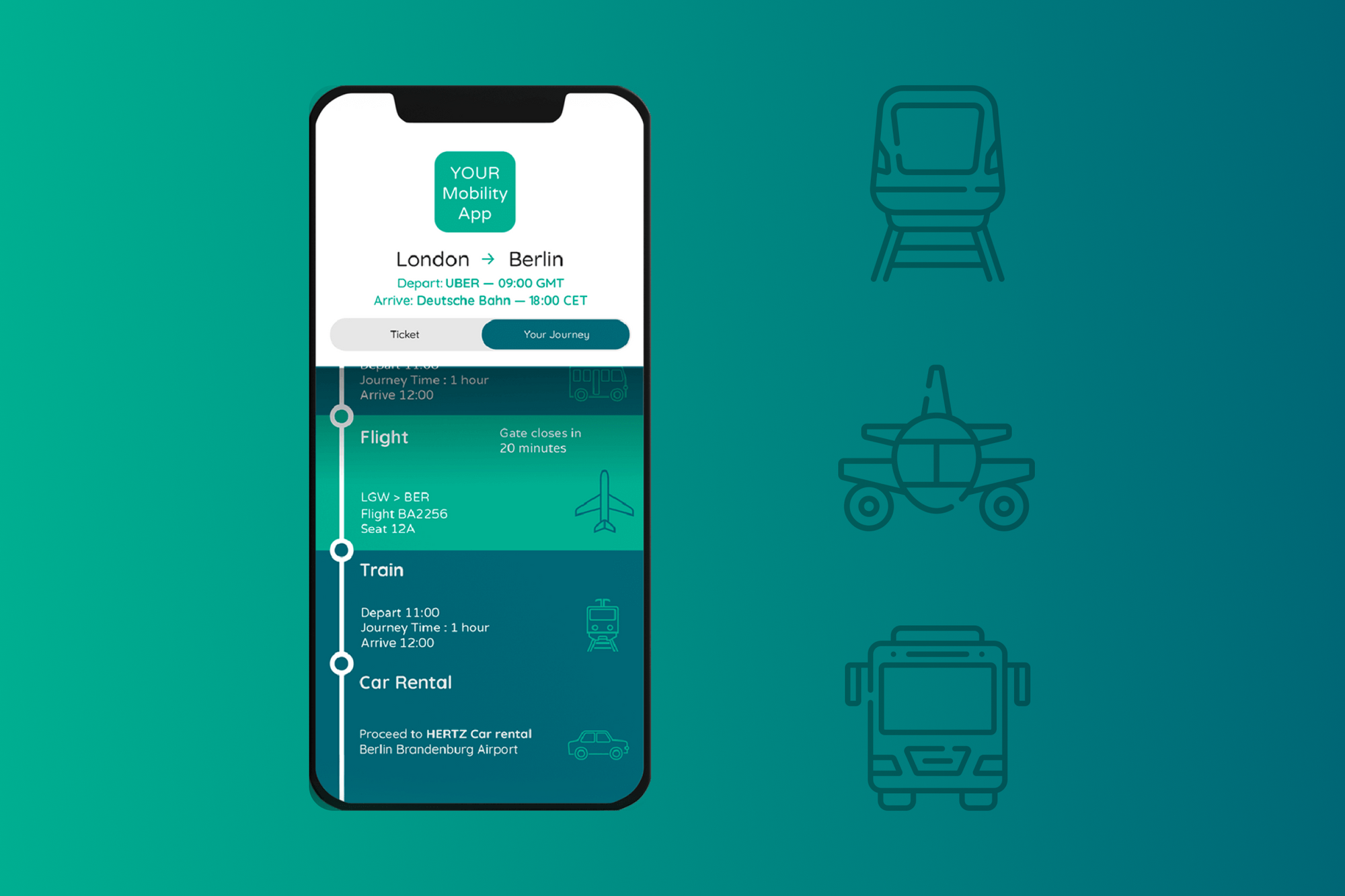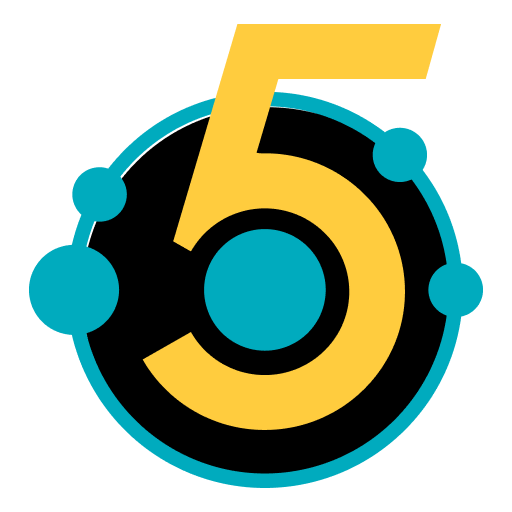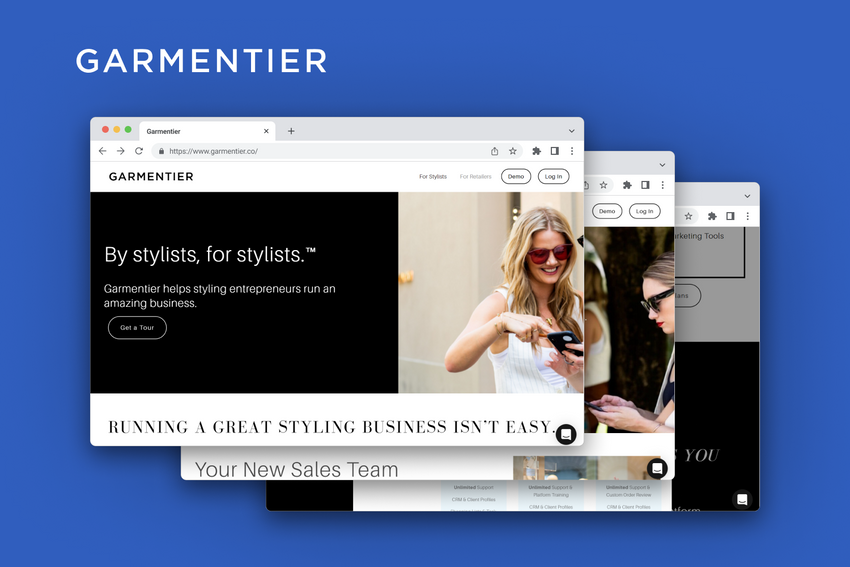Micro SaaS Applications For Small Business: Best SaaS Ideas to Build Product in 2024
15 profitable SaaS product ideas to realize in 2024.
The juggernaut of big enterprises is often merciless towards their smaller size fellows. That’s why we want to present you with 15 SaaS ideas for small business that help dodge the implacable force and build a highly demanded product.
What Is the Difference Between SaaS Tools and Traditional Software?
There is a common misconception that starting any kind of business entails the development of full-scale custom software. But SaaS made this beaten path obsolete.
So, before jumping straight ahead to the list of SaaS ideas, let's first find out the difference between SaaS solutions and traditional software.
The concept of SaaS boils down to the following: hosting, operating, and maintaining software is on the shoulders of a vendor, while the company that buys a SaaS product simply uses it via the internet. Thus, no additional hardware and a team of developers and QA engineers are needed, as long as a company pays you to rent a web app or a web platform that is located in the cloud.
The software that is also known as traditional, on-premises, and enterprise software is built from scratch for a particular company. It’s hosted and maintained on-site by the business, which, obviously, demands much higher expenses and up-front costs.

Oftentimes, traditional custom software that was purchased by a small company becomes another "white elephant" to take care of, so this solution is more feasible for large enterprises.
In simple terms, think of it as renting a flat. Why buy one’s own right away if they can occupy your fully furnished apartment until it becomes financially reasonable to purchase personal housing?
We're not saying that SaaS are built for newcomers to business only. It's true that startups find it more advantageous to use SaaS products because the financial foundation may not be strong enough, but as we will see further, big and stable enterprises can implement them as well. But let’s not jump ahead.
To have an even better understanding of SaaS, let’s go over the most widespread SaaS providers, whose services we use every day. For example, by paying the subscription fee for Netflix, we can watch licensed TV shows and movies. Gmail and other online email platforms are SaaS as well.
And, wow, Microsoft Office 365 is also a SaaS that gives access to productivity, cloud storage, and collaboration online services on a subscription basis.
Now when we have started to comprehend why SaaS is one of the most lucrative business models today, it’s time for us to find out about the different types of SaaS.
3 Types Of SaaS
SaaS can be classified according to the range of industries they’re used for. Today, SaaS apps are a common practice in practically every sphere, from FinTech and e-Commerce to education. But according to how many sectors one platform serves, three types of SaaS tools for business are distinguished: horizontal, vertical, and micro.
Horizontal SaaS
The horizontal SaaS business model provides services for a wide range of customers from different fields. Moreover, the horizontal SaaS models are able to expand the number of functionalities provided to companies, if they need them, and even the array of industries they cater to. The two most common examples are Salesforce and Microsoft.
Vertical SaaS
Vertical SaaS tools are aimed at a narrower audience and serve their specific needs. For example, it can be a patient management platform targeted at clinics and healthcare institutions.
Both have their own benefits. For instance, those who go for vertical SaaS development believe that it’s easier to focus on the standards and demands of a particular sector to create an exceptional platform.
At the same time, the ones who resorted to building horizontal SaaS applications claim that businesses from different spheres share more common features than distinctive ones. So concentrating on them is a much better idea.
Micro SaaS
Products created by a small team of engineers and targeted to serve small companies in a narrow industry are usually referred to as "micro SaaS". This type of SaaS resembles the vertical model and can be considered its subtype.
On the whole, such apps help solve even more specific problems. Let's say that a vertical SaaS is built for the education sector in general, while a micro SaaS app for the same field is built for the needs of high school students.

As we’ve mentioned, the SaaS market is dominated by several big players. But it doesn’t mean that you have to compete with them, given that it’s not a level playing field, especially if you’re only at the beginning of your journey.
Instead, you may complement their products with your micro SaaS solutions. These are not only apps for CRM or workforce management that will be described below, but micro SaaS may take the form of plugins or add-ons. Just like Grammarly, which works in browsers and checks the spelling.
Selecting the right type of SaaS is, undoubtedly, of great significance. But the key to an excellent custom web application is the right team, which, in turn, will help you choose the type of SaaS most compatible with your business needs.
Benefits of Micro SaaS for Small Business
Whether you’re dipping your toes in the waters of enterprise or a small business owner who wants to migrate their on-premises product to the cloud and convert it into SaaS software, most certainly it will become a worthwhile investment. Your SaaS tool will be in great demand due to the number of advantages of SaaS products. Let’s cover some of them.
Cost and Time Efficiency
The benefits of SaaS can only be revealed through their comparison with on-premises software, and let us point out once again that SaaS demands much lower upfront and maintenance costs than traditional software.
The cost and time efficiency of SaaS become apparent once a user understands that they don’t have to wait months as with traditional software and that no additional hardware is needed. Instead, they simply get on the internet, log in, and voila! And yes, with SaaS, businesses save a lot of money on the lack of IT and, sometimes, even back office workers. Just think of how many resources are saved with the help of all the cloud-based SaaS tools that automate business processes and don’t demand installation.
Scalability
Regardless of what kind of company uses SaaS, be it a small business, a startup, or a big enterprise, they all tend to grow (by the way, with the help of SaaS tools). Hence grow the team, the customer base, and the range of products and services they offer.
The distinctive feature of SaaS is that they can be modified and remolded simultaneously with the advancement of business. And this possibility of enhancing a SaaS with additional features and functionalities gives SaaS one more point.
Besides, new updates to a product are the vendor's responsibility as well. So pay heed to the regular introduction of improvements, as it will increase the satisfaction of users and hence your profit.
Flexible Payment Options
Most of the existing products are subscription-based. It means that a company picks the period of time during which it’ll be using your SaaS tool and pays for it.
Once the subscription expires or a company decides to stop using your SaaS solution, their access to the software is blocked. And, vice versa, if a company needs an enhanced version of an app or to scale a business, it will have to pay a higher price.
As a part of their marketing strategy, SaaS owners often let potential customers kick the tires before buying the subscription and offer a trial period for a certain period to attract more customers.
15 Best SaaS Ideas For 2024
Now, we shall stop titillating you and finally proceed to describing the best ideas for small business.
- SaaS-based CRM (Customer Relationship Management)
It goes without saying that every business wants to retain and attract more customers. That’s why SaaS CRM software is one of the most popular products to develop. CRM systems help to provide a customer with a personalized experience by gathering and organizing data from different sources and analyzing users’ behavior on a website.

Moreover, SaaS-based CRM can be integrated with various customer support and feedback tools to always keep updated on how satisfied customers are, which is crucial at all stages of business development.
A lot of people today opt for CRM development, which is why it’s a highly competitive field. But why should competition hamper your progress? Instead, it can become an incentive to work out something one of a kind. In the end, it’s easier to stand out in the sea of mediocre software products, isn’t it?
2. Accounting and Billing SaaS Tools
As we’ve decided to start with the most essential constituents of all kinds of businesses, we can't help but cover finances. Accounting departments have to be highly precise in their calculations and analyze financial data. As the processes are directly connected with the effectiveness of a whole enterprise, a lot of business owners resort to SaaS finance software to receive detailed financial reports, manage taxes, and create bills.

Automating financial operations is not the only thing possible with SaaS software, but it can be integrated with various financial services and even banks to keep track of all transactions and balances on bank accounts.
If the field seems too broad for you, it’s possible to build a SaaS finance product for a particular industry and focus on the features that can only be implemented in FinTech, restaurant businesses, or something else.
3. Remote Monitoring and Management (RMM)
Actually, this type of SaaS encompasses all the apps needed for remote work, thus combining project and workflow management, collaboration, time tracking, and file-sharing tools. SaaS remote monitoring and management software is used in any industry where workers work from home or are located in different parts of the world.
The COVID-19 pandemic revealed the convenience of remote work, so more and more companies go completely online. For many businesses, especially startups, renting an office was one of the biggest expenditures. Today, RMM platforms help them save money and redirect the surplus towards business development.
4. Password Managers
With a million websites and apps we register on every day, password managers truly come in handy, considering that we’re making them inordinately sophisticated and complex so that our sensitive data won’t be stolen.

The security of information is even more important for businesses, as they don’t only risk the leakage of their personal data but also the private records of their customers and employees. At the same time, some workers can store their passwords on phones and computers, risking the security of a whole team.
For this reason, one of the best SaaS tools for business is a password manager that can keep all the passwords and logins protected and stored in one place so as not to gobble up the brain’s or phone's memory.
5. SaaS Tools for Communication
If we need to find something that all companies have in common, it's communication. It’s the cornerstone of all the business processes; hence, every business owner understands the need to have agile software products for information exchange.
A SaaS app for effective team communication is a good idea by itself, but building one empowered by a set of unique features and messaging options will certainly have a solid competitive advantage.
6. SaaS-based Project Management
The value of wise project management can’t be underestimated, given that workers need time and guidance to become a solid team. SaaS tools for project management can help businesses streamline the processes of collaboration and communication, as, besides other advantages, most of the SaaS tools can be accessed from various devices.
For project managers, such SaaS tools can become the magic stick for resource and project planning. Usually, project management SaaS enables the insertion of customized features based on the business needs of a particular company. It can be a dashboard, clear schedules, or notifications about task status.
7. KPI Tracking Tool
The performance of workers is directly connected with the performance of the whole enterprise. This is why it should be constantly tracked to, as harsh as it may sound, weed out underperforming workers.
But KPI tracking tools are not only murder tools for meting out punishment for loafing employees. They are leveraged to reward top performers for their hard work or encourage competition among the employees. Still, you’d better make sure that it’s done in a healthy way, as too much competition can sabotage the entire workplace.
All these functionalities of SaaS KPI trackers can also serve freelancers, who, being their own bosses, praise and reprimand themselves... by themselves.
8. Conversion Rate Optimization (CRO)
CRO tools are used to analyze users’ behavior on your website. Usually, business owners are presented with visually pleasing reports and diagrams.

For instance, some CRO SaaS tools can show how a user interacts with an online shop step by step. Some can present the number of visits and the speed of loading.
9. Enterprise Resource Planning (ERP)
ERP is a web platform that encapsulates many apps and tools. Financial operations, projects, supply chain and risk management, analytics, and even procurement—all these can be tracked and automated via ERP.
In essence, ERP can embrace all activities inside one company, from marketing and accounting to human resources. Business owners often opt for this SaaS solution because it’s easily expandable, so additional features that would cover another business activity can be added as the business grows.
10. Content Management Tool
The battle for customers’ attention is intensifying, and one of the tried-and-true methods of winning the attention of clients is captivating content.

For this reason, SaaS tools for content management will be popular for years to come. A great micro SaaS idea can be a tool for editing and publishing content or one for producing SEO-optimized articles and blog posts.
11. Human Resources (HR) SaaS Tools
Another pillar of every successful venture is the satisfaction of employees. They need to be informed on all the recent updates pertinent to their position and properly trained.

Most importantly, they need to be sure about their work and holiday schedules. SaaS for HR is built to effectively implement all these functions.
12. e-Commerce SaaS Platform
Currently, every other person manufactures and sells a product. There is no use for newbies to e-Commerce to build their own online shop from scratch, so most of them leverage customized SaaS platforms.
One of the best examples of e-Commerce SaaS solutions is Shopify. Basically, it allows a person to start selling their products immediately by providing each seller with the tools to compile their own e-Commerce website and fill it with a set of ready-made features.
Marketplaces are extremely popular among individuals and businesses who want to sell their products fast and with minimum expenses. Taking into account that the number of online vendors will only continue to grow, building an online marketplace is another profitable e-Commerce SaaS development idea.
13. SaaS Healthcare Application
Companies involved in the healthcare industry have always been in the vanguard of adopting new technology. Thus, the usage of SaaS in healthcare is not uncommon.
Of course, patients are the focus of attention in every clinic, which is why one of the most popular SaaS solutions is patient portals. Among the most innovative healthcare SaaS examples is SNAP.

It includes a patient portal that makes it possible to schedule appointments with doctors and remind patients about them. Moreover, SNAP makes it easier to manage medical records and automates the process of billing and other paperwork so that doctors can concentrate solely on patients’ treatment.
Actually, you can resort to SaaS web portal development even if your future business is not connected to healthcare but to any other industry. It can be, for example, education.
14. E-learning SaaS
Incessant education is one of the biggest trends. Every other day, a new set of skills emerges that people feel obliged to dive into or acquire at all costs. Today, almost everyone will learn programming languages or die trying. Tomorrow, a baking or jewelry-making craze may appear.
So, e-learning platform is an excellent place to publish online classes and reap profit. They do not necessarily need to serve schools, but any company that deems it beneficial to share their knowledge and skills. Some business owners can jump at the opportunity to increase awareness about their services and products through online lessons. Some will genuinely enlighten people through high-quality content. Regardless of their purposes, your e-learning SaaS will aid them in the process.
15. Property Management SaaS Platforms
Last but not least is real estate SaaS. Remember the metaphor we’ve used above? The idea is applicable here as well, but now in its literal meaning. So many people are renting their apartments and have to deal with landlords, paying rent, utility bills, and documentation. Here, property management platforms come to help.

Modern property management platforms aim to automate payments and transactions through the integration of various accounting and payment gateway systems. They also alleviate landlords’ problems and allow them to view requests, schedule meetings with prospective tenants, and some even provide them with a visual revenue dashboard.
We can't but notice that some real estate SaaS solutions allow you to track lights and cameras and even predict potential maintenance issues in a home. Wondering how it’s possible? The Internet of Things and Artificial Technology are to be praised for it.
Having learned the best SaaS development ideas and their types, you’ve probably formed your thoughts about your future SaaS. Now, don’t you think that it’s a good time to explore some SaaS trends that may serve as a prompt for your unique SaaS tool.
Hot SaaS Trends
It’s predicted that by 2028, the value of the SaaS market will reach more than $720 billion. This means that SaaS products will only grow in popularity in the next several years. The rapid growth implies the rise of innovation and novelty at the same speed. Here are some of the SaaS trends expected to permeate the SaaS market in the following years.
Identity-Access Management Automation For SaaS
One of the major drawbacks of SaaS was the insufficient level of safety. One of the reasons was that SaaS are usually multi-vendor.
But IT engineers came up with the solution: Identity and Access Management. This system defines the way users can access information and the level of their access to different layers of data within a company.
Once the system is implemented correctly in a SaaS, you and your users can be sure that their data is kept safe and protected against unauthorized users and hackers.
Artificial intelligence (AI) and Machine Learning (ML)
AI and ML are ubiquitous. These technologies are becoming more and more sublime for advancing all kinds of software, including SaaS products. Onerous and redundant tasks automation, forecasting customers’ purchases, and processing bulk of data are only some of the tasks AI and ML can tackle.
For example, there is a SaaS for e-Commerce, that prevents fraud in the payment process with the help of Artificial Intelligence and Machine Learning technologies. It allows for proxy and geolocation detection to help a company reject or accept a transaction. Many e-Commerce SaaS are integrated with AI-driven chatbots to personalize data and effectively help customers.
Integrations
SaaS products will be integrated with other apps located in the cloud or even on-premises software so that users don’t need to jump from one app to another but can leverage the functionality of several products in one place.

For example, an e-Commerce SaaS platform can be integrated with CRM and content management tools, which will eventually result in a more sophisticated marketing strategy and, of course, an exceptional user experience.
Vertical SaaS
The type of SaaS products tailored to the needs of a niche segment of the audience will probably continue to rise in popularity. It supports the fact that the number of searches for vertical SaaS solutions increased by 28% from 2018 to 2023.
So maybe investment in building SaaS applications for a specific niche market is your key to success?
SaaS-based No-Code Platforms
The blame for the rise of no-code platforms should be put on the global pandemic. This period made many companies face the problem of a lack of highly skilled testers, and this is when no-code platforms received their long-desired recognition.
Now, SaaS-based no-code platforms are adopted by many companies as they can be operated by non-tech savvies. In the context of testing, no-code platforms are particularly transformative. They offer a simplified approach to creating and executing tests, which previously required considerable coding skills. According to some forecasts, in the near future, the new coding technology is expected to replace some IT engineers involved in testing.
Blockchain SaaS
One more pillar of cybersecurity can be provided by blockchain technology. Without getting into the intricacies, it is basically the data coded with the help of cryptography and put in chronological order.
Initially, the technology was associated with cryptocurrencies, but it later revealed its full potential. Today, blockchain keeps the personal data of customers and information about transactions coded with cryptography. The encrypted data itself is packaged into a number of blocks.

Consequently, the more blocks you have, the more protected the data is. What's more, the information inside these blocks is difficult to change because everyone who is attempting to do so is easily traceable via a decryption code, which functions like a unique signature in the blockchain world.
Forecasts include the following: A new trend is emerging, and its name is "Blockchain-as-a-Service". It’s in its nascent state, but only for now. Today, though, blockchain technology is massively implemented into SaaS products.
So Can I Really Build My Own SaaS Product?
One problem surfaces every time someone decides to launch a business, and the problem is money. But the modern world retaliates against outdated patterns and makes it possible for every aspiring entrepreneur to show their mettle without having billions of dollars in a bank account.
Even if you’re not an oil tycoon, it’s still possible to create a SaaS app that will bring you lots of income. We don’t need a crystal ball to bet that it’s not a temporary craze and SaaS-based products will remain on the lists of web development trends for many years to come.
Whether you found a perfect app idea or the thought of building a SaaS app gets you inspired, contact us. Right now we provide consultation and estimation services for free to answer all queries you have on your mind.
Need Help With A Project?
Drop us a line, let’s arrange a discussion















